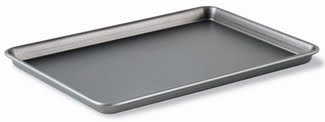 |
| Aluminum jelly roll pan Equally good for waking up heavy sleepers. |
It would seem the natural choice is to use a cookie sheet, since the very name implies suitability for the task. Many people refer to a "jelly roll pan" (aka "half sheet", "full sheet" etc.) as a "cookie sheet". But they're not the same. A cookie sheet has low or no sides to promote even baking of cookies, and allow them to slide off easier. A jelly roll pan has raised sides all around.
Alas, I gave my large air-insulated cookie sheet away long ago, because I never baked cookies. So as a replacement, I bought a non-stick heavy duty commercial grade jelly roll pan. I couldn't say no when I saw it, it was staring me in the face and wouldn't look away. It was to be my pan of all trades; cookies, roasting, broiling. Most things I'd do in an oven. From the heft and weight, and the fact that it stated "commercial grade", I convinced myself that I needed this pan, because it would not warp at high heat. Something I always hated about the cheapie baking pans. Well guess what it warped like anything else. However, this is not a good pan to put under high heat anyway. Non-sticks containing PTFE (ie. Teflon) break down over 450F. To be safe, it's probably not a good idea to heat such a pan above 400F. And after super-modding the insulation in my oven, it can easily do 600F on the bake cycle. So I found myself looking for a replacement for the replacement.
I still didn't want to commit myself to just a cookie sheet, and reserve space for yet another tray that I might not use very often. But this time, I decided to stop messing about buying baking pans from a grocery store chain. I went straight to my favourite source for such items: a restaurant supply shop. There I bought a nameless aluminum jelly roll pan. It had no fancy "commercial grade" labels on it. No brand or labels at all in fact. But sitting in a restaurant supply store meant by definition, it was commercial grade. Does that mean it doesn't warp under high temperatures? I'm happy to say, it hasn't yet. Now how does it do cookies?
 |
| Brazilian Banana Cookie vs. African Banana Cookie |
 |
| Non-stick jelly roll pan. Named after jazz great, "Jelly Roll Morton". |
Conclusion: It makes a great difference what you bake your goods on. Mind, a good cook doesn't blame his utensils. Unless it's the fault of the utensils, which it usually is. These things have a mind of their own, I swear. Oh, and I found a solution to not storing a dedicated cookie sheet: turn the aluminum pan upside down.









0 comments:
Post a Comment